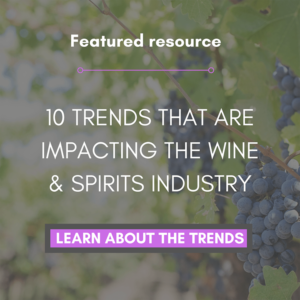Wineries are cutting out the middleman and selling directly to consumers—and Americans are loving it. With wine shipping laws evolving, more wineries are allowed to ship directly to the consumer than ever before.
The DTC channel hit $3 billion in 2018, up from $2.66 billion in 2017, according to Wine Vine Analytics. The channel is forecasted to grow around 11% a year, reaching $5.2 billion by 2022. How can wine suppliers take advantage of this trend and what are some of the challenges they may face? Let’s take a look.
Rapid growth of direct-to-consumer channel
Currently, the winery direct-to-consumer (DTC) channel only compiles 2% of the total US market in terms of volume, but the rapid growth of sales volume—15.5% to be exact from 2016—it suggests there is huge potential in this channel for wineries.
“Over the past five years, we’ve seen American consumers embrace direct wine shipments as a way to purchase the wines they love, and now the channel has progressed into a tremendous growth opportunity for wineries across the country,” said Larry Cormier, general manager, beverage alcohol and eCommerce at Sovos.
“The DTC wine shipping channel is outperforming every other retail channel in the country, and as the wine industry continues to evolve and eCommerce swells,” he said.
Where the wine is
 There are now nearly 10,000 wineries across the U.S., but some are small, family-owned vineyards that don’t have large-scale marketing and disruption budgets. The DTC shipping channel has been driven historically by smaller wineries, but now is even gaining momentum from larger wineries as enotourism, travel specifically to consume or taste wine, grows.
There are now nearly 10,000 wineries across the U.S., but some are small, family-owned vineyards that don’t have large-scale marketing and disruption budgets. The DTC shipping channel has been driven historically by smaller wineries, but now is even gaining momentum from larger wineries as enotourism, travel specifically to consume or taste wine, grows.
In 2018, wineries shipped more than 6 million cases of wine directly to consumers. This is an increase of 9% from 2017. When buying directly from the wineries, consumers are willing to pay more. The average price-per-bottle in these cases increased, as well, to $39 a bottle.
The Sonoma and Oregon wine regions saw a 19% growth of their direct-to-consumer channel, and Washington followed with a 13% growth in sales. Sonoma leads the pack with the most cases shipped to consumers—1.8 million cases.
The most commonly shipped wines were Cabernet Sauvignons, Pinot Noirs, and red blends. But shipments of rosé skyrocketed 24% in 2018, and increased 200% since 2010, according to Sovos.
Who is buying the wine
Of the 6 million cases shipped, the top destinations were to customers in California, Texas, New York, Washington, Florida, Illinois, Oregon, Colorado, Virginia, and Pennsylvania. These same 10 states also fall into the top 10 states for wine production.
California remains the most popular destination to both ship and receive wine, with nearly one-third of total volume and value of all winery-to-consumer shipments nationwide hailing from the Golden State.
Pennsylvania, typically known for its state’s constraining and limiting liquor laws, saw impressive growth, with a 28% increase of volume shipped for a total of 152,000 cases. This was the state’s first full-year of allowing DTC, and it was well received, with no indication of sales slowing down.

Why direct-to-consumer works
While the internet doesn’t seem to like anything new, wineries turning on their online sales is a fresh approach to reaching consumers. The ability to allow customers to select and purchase wines online has unlocked the direct-to-consumer channel for vineyards.
Enotourism is continuing to thrive. So while customers are visiting the vineyard, wineries are marketing directly to drinkers on site. Wineries offer customers a chance to become members, and offer some wines exclusively to its members to entice people to join.
The wine pourers will hand visitors a pamphlet encouraging them to become members, or to make a one-time purchase that can be shipped home. The cost of the pamphlets is significantly less than if the winery had to launch a full-fledged marketing campaign, and it allows wineries to sell their wine at a higher margin. However, they do need to be able to support the shipping logistics of a wine club.
Featured resource: 10 Trends in the Wine & Spirits Industry—Read now
The challenges
While jumping on the DTC bandwagon may seem like a strong sales channel, there are many regulatory hurdles that wineries face.
Each state has different laws about the shipping and receiving of alcohol. So while it’s OK to ship wines from California, you are not allowed to ship them to Alabama. This can disappoint customers, so you have to train your staff to be familiar with the regulations.
States are frequently changing their laws, like Pennsylvania, but the overall the change is slow.
Earlier this year, wineries leading the trend in this space said at the Direct To Consumer Wine Symposium that wine club members and tourists are looking for more information, interaction, and a personalized touch to each shipment. This means wineries need to staff and provide that experience to keep members fulfilled.
If you’re looking to start a DTC channel and you have a tasting room, you can start with a small goal of how many cases you’d like to ship. Offering your direct-to-consumer channel strictly to winery visitors is a nice exclusive marketing trick to increase sales, but ensure your volume is manageable.
As you increase sales and shipment, you can later decide to offer online sales of your wines.
Related reading
- 87% of Utilities Have Experienced at Least One Data Breach in Last Three Years - February 5, 2024
- Can Drones Lower Your Next Utility Bill? - January 10, 2024
- Onshore Wind Farms Are The Next Big Thing In Renewable Energy - December 6, 2023



